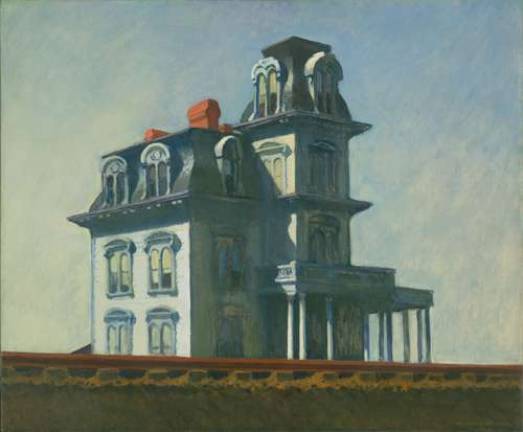Hopper at the Movies

How modern sensibility went from canvas to screen
In the Museum of Modern Art's current exhibit "American Modern: Hopper to O'Keefe" viewers can survey the creation of modern sensibility and realize its impact from one medium to another.
If the art of cinematography is, as film critic Armond White succinctly put it, "the idea of the scene made visible," Edward Hopper's project was to paint scenes that made visible his ideas-ideas suggestive of silent narratives, evocative and ambivalent stories, human nature revealed.
In "House by the Railroad" (1925), Hopper captures an essential antimony of the American scene, a displaced Victorian home pictured from slightly below a railroad bed in the harsh shadows of dusk. It's a deliberately small canvas, really, only 24 by 29 inches, shorn of Hudson River-school scale or luminist's purpose, and the space to each side of the home-with its mansard roof, columned portico, and eclectic architectural references-is just wide enough to suggest its yawning isolation on the plain, and just narrow enough (it's taller than it's wide) to suggest something encroaching. Hopper builds up the backdrop sky with oily layers of turbidity. The air looks fetid, heavy, enveloping, before a storm has left ionized freshness in its path.
But it's the railroad tracks that tell the story of East meeting West, movement versus stasis, the pioneering and wandering urge struggling with domesticity, civilization, roots, home. One can hardly imagine a less romantically rendered version of that quintessential symbol in the history of Western art-no graceful, perspectival receding to the background, no dynamic eye-directing oblique, just an iron, intrusive ugliness in what looks like newly scarred land, laid without regret before the shadowy remnants of the belle époque-itself a displaced Euro conceit. Or did the railway, in all its functional simplicity, make this ornate American dream possible?
"House by the Railroad" stands among Hopper's most influential paintings, not only on other painters but on the cinema as well. Terrence Malick's Days of Heaven (1978), for example, expressed the dynamic of the painting's narrative tensions, while seeming to conflate Hopper's Victorian manse with Andrew Wyeth's Hopper-inspired "Christina's World" (1945), pregnant with post-war anxiety about innocence lost to worldliness. Then, again, Malick's homestead imagery may have paid homage (as is the funeral scene in Shane to Days' blessing of the wheat) to George Stevens Jr.'s Giant.
In any case, in the years following Days of Heaven, Hopperesque imagery was resurgent in movies, most prominently in the underappreciated recreations of Hopper's world-not as in tableux vivants but via the rigorous lighting and composition of the late, great Laszlo Kovacs-in Heart Beat (1980), a cinematographic masterpiece. Next came Gordon Willis's splendid turn in Pennies from Heaven (1981), and Pierre Mignot's work in Robert Altman's Come Back to the Five and Dime, Jimmy Dean, Jimmy Dean (1982). "Then," to paraphrase John Winger in Stripes, "Depression set in."
"American Modern: Hopper to O'Keefe" shows at the Museum of Modern Art through January, 2014.